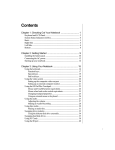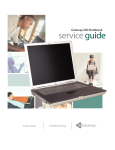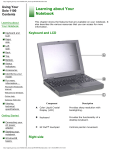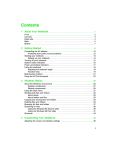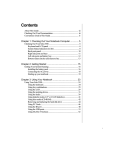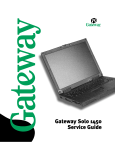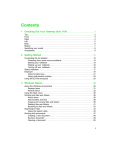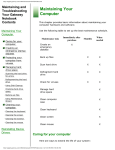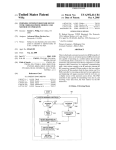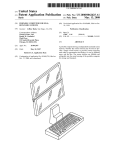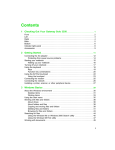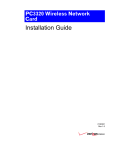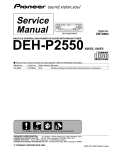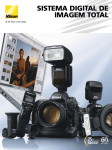Download SOLO 2550 USER MANUAL
Transcript
Using Your Solo 2550 Contents Using Your Solo 2550 Contents Learning about Your Notebook Keyboard and LCD Learning about Your Notebook This chapter shows features and options that are available on your notebook. It also describes the various resources that you can access for more information. Keyboard and LCD Front Back Right side Left side Bottom System status indicators For more information... Accessories Using Your Notebook Connecting AC power Turning on the notebook Using the keyboard Function · combination keys · Pad Lock keys Using pointing devices Using the EZ Pad · touchpad Component Description A TFT Color Liquid Crystal Display (LCD) Backlit anti-glare screen B Keyboard Provides the full functionality of a desktop computer keyboard. C EZ PadTM touchpad or EZ PointTM stickpoint Controls the pointer movement on the screen. · Using the EZ Point Connecting an · external mouse Using audio · Adjusting volume · Making an audio recording Front http://support.gateway.com/s/Mobile/Solo_Series/p2550/8505460/index.htm (1 of 9)7/28/2004 7:11:47 AM Thank you for purchasing this Factory Service Manual CD/DVD from servicemanuals4u.com. Please check out our eBay auctions for more great deals on Factory Service Manuals: servicemanuals4u Using Your Solo 2550 Contents Changing the audio · source · Playing CDs · Playing DVDs Using video Changing screen · resolution Connecting the modem Using PC Cards Using USB ports Using the infrared port Component A Microphone Use to record sound when the system is recording. B Power LED Check LED for notebook power status: Steady green - power is ON. Replacing the hard disk drive · Description Blinking green - notebook is in suspend or standby mode. The LED flashes every four seconds. Preventing static electricity LED off - power is OFF. Managing Power Use Checking battery status Maximizing battery life Swapping batteries C Cover release button Open notebook cover by sliding right. D CD/DVD drive Insert data or audio CD discs into this drive. Optional DVD drive reads DVD and CD discs. E CD/DVD Eject button Press to eject the CD/DVD tray from the drive. Recalibrating the battery Managing power Back · Windows98 Windows95 and · WindowsNT Using the Power menu Using the Internet Learning about the Internet Setting up an Internet account Accessing your Component · Internet account http://support.gateway.com/s/Mobile/Solo_Series/p2550/8505460/index.htm (2 of 9)7/28/2004 7:11:47 AM Icon Description Using Your Solo 2550 Contents Using the WorldWideWeb A Parallel port (LPT1) Connect a parallel device such as a printer to this port. B Docking port Connect an optional docking station to this port. C IR (Infrared) port Enable this port to connect your notebook to separate devices (printers, peripherals, other computers) using infrared signals that travel between the notebook and the remote device. D VGA port Connect an external monitor cable to this port. E Serial port Connect an optional serial device to this port. Connecting to a · Website · Downloading files Using email · Sending e-mail · Checking your e-mail Safety, Regulatory, and Notices · American users · Canadian users · European users · Japanese users Australia and New · Zealand users Right side Component Icon Description A Diskette drive or LS120 drive Insert either a standard or LS120 diskette (for LS120 drives only) into this slot. B Diskette drive eject button Press the eject button to remove a diskette from the drive. C Modem jack (optional) Connect the notebook onboard modem to an analog phone system by plugging a phone line into this jack and to a phone wall jack. http://support.gateway.com/s/Mobile/Solo_Series/p2550/8505460/index.htm (3 of 9)7/28/2004 7:11:47 AM Using Your Solo 2550 Contents D PC Card eject buttons Press the eject button to remove PC Cards from PC Card slots. See "Using PC Cards for more information. E PC Card slots Insert PC Cards Type I, II, or III into these slots. See "Using PC Cards for more information. F PS/2 port Connect the keyboard, mouse, numeric keypad, or other external device to this port. G Power connector Connect the AC power adapter to this port. . Left side Component Icon Description A Kensington lock slot Attach a Kensington lock cable into this slot. B USB (Universal Serial Bus) ports Plug USB serial devices into these ports. C Battery bay Insert battery into this bay. D Mic In Connect an external microphone to this port to record audio (1/8-inch/3.5mm jack). http://support.gateway.com/s/Mobile/Solo_Series/p2550/8505460/index.htm (4 of 9)7/28/2004 7:11:47 AM Using Your Solo 2550 Contents E Audio Line In Connect an external audio input source (computer, stereo, VCR, etc.) to this port to record or play audio through the notebook speakers (1/8inch/3.5-mm jack). F Speaker Out/ Headphone jack Connect external speakers or headphones to this port. Supports small unamplified speakers (1/8-inch/3.5mm jack). G Volume wheel Use to adjust volume for built-in speakers, external speakers, and headphones. Other port volume levels are controlled by multimedia software. Bottom Component http://support.gateway.com/s/Mobile/Solo_Series/p2550/8505460/index.htm (5 of 9)7/28/2004 7:11:47 AM Icon Description Using Your Solo 2550 Contents A System identification label Find the product model number, serial number, display type, and processor speed on this label. B Diskette drive slot Insert either a standard diskette drive or LS120 drive into this slot. C Battery release latch Slide to release battery pack. D Hard disk drive bay Open the cover to replace hard disk drive. E Memory bay Open the memory bay cover to install or remove SO-DIMM memory modules. System status indicators This indicator icon appears... Battery gauge http://support.gateway.com/s/Mobile/Solo_Series/p2550/8505460/index.htm (6 of 9)7/28/2004 7:11:47 AM when... A battery is installed. It shows battery activity and status. Using Your Solo 2550 Contents Charge A battery is charging on AC power. Turns off when battery is fully charged. AC power adapter The notebook is powered by the AC adapter. Hard drive The notebook accesses the hard drive. Diskette drive The notebook accesses the diskette drive or LS120 drive. CD/DVD drive The notebook accesses the CD/DVD drive. Scroll lock The scroll lock is enabled. Pad lock The pad lock is enabled. Caps lock The caps lock is enabled. System docked The notebook is docked. For more information... In addition to this user guide, these resources are available to help you get the most from your Gateway notebook: Maintaining and Troubleshooting Your Gateway Solo Notebook This manual contains information about managing system resources, preserving your system performance, reinstalling your operating system and drivers, and troubleshooting. Microsoft Windows manual This manual addressed many questions about Windows for both beginners and advanced users. Use this manual to find information about using the operating system, getting help, using applications, organizing your files, troubleshooting, maintaining your notebook, and learning about advanced features such as connecting to a network. Welcome to Windows http://support.gateway.com/s/Mobile/Solo_Series/p2550/8505460/index.htm (7 of 9)7/28/2004 7:11:47 AM Using Your Solo 2550 Contents The interactive Windows tutorial helps you become more familiar with Windows features and learn more about using and getting the most out of your notebook. The tutorial opens when you first start Windows. If you want to use the tutorial later, click Start, then select Programs, Accessories, System Tools, then Welcome to Windows. Online help Most applications provide online help. You can use online help to find out more about the application and to get information about how to complete tasks. To use help, select Help or Contents and Index from the Help menu in an application. When the help window opens, you can select one of three tabs: Contents provides a list of topics and help information about tasks you can do in Windows. Index lets you search the entire help file for topics using keywords. Keywords are assigned to each help topic. Search lets you search for any word that appears in a help file. Microsoft Office assistants In addition to standard help, Microsoft Office applications provide animated characters called assistants. You can ask an assistant a question to get information about a task. To use an assistant, select Help from the Help menu in a Microsoft Office application, then click Help. Gateway Web site (www.gateway.com) If you have a subscription to an Internet service provider, visit the technical support section of the Gateway web site for notebook support help, system specifications, technical documents, tech tips, frequently asked questions (FAQs), glossary, software library with BIOS updates, and other resources that can help you make the most of using your notebook. Accessories Gateway offers various accessories that can help you make the most of using your Solo notebook: Port replicators Docking stations Battery packs Battery chargers Automobile/airplane adapters http://support.gateway.com/s/Mobile/Solo_Series/p2550/8505460/index.htm (8 of 9)7/28/2004 7:11:47 AM Using Your Solo 2550 Contents Memory modules External keyboards External monitors Speakers Carrying cases Printers Tape backup units Hard drives Modems Network cards Software Uninterruptable Power Supplies (UPS) For more information on these or other Gateway accessories for your notebook, visit our Web site at www.gateway.com or call 1.800.846.2000. http://support.gateway.com/s/Mobile/Solo_Series/p2550/8505460/index.htm (9 of 9)7/28/2004 7:11:47 AM Learning about Your Notebook Learning about Your Notebook This chapter shows features and options that are available on your notebook. It also describes the various resources that you can access for more information. Keyboard and LCD Component Description http://support.gateway.com/s/Mobile/Solo_Series/p2550/8505460/05460ch0.htm (1 of 11)7/28/2004 7:11:50 AM Learning about Your Notebook A TFT Color Liquid Crystal Display (LCD) Backlit anti-glare screen B Keyboard Provides the full functionality of a desktop computer keyboard. C EZ PadTM touchpad or EZ PointTM stickpoint Controls the pointer movement on the screen. Front Component Description A Microphone Use to record sound when the system is recording. B Power LED Check LED for notebook power status: Steady green - power is ON. Blinking green - notebook is in suspend or standby mode. The LED flashes every four seconds. LED off - power is OFF. C Cover release button Open notebook cover by sliding right. http://support.gateway.com/s/Mobile/Solo_Series/p2550/8505460/05460ch0.htm (2 of 11)7/28/2004 7:11:50 AM Learning about Your Notebook D CD/DVD drive Insert data or audio CD discs into this drive. Optional DVD drive reads DVD and CD discs. E CD/DVD Eject button Press to eject the CD/DVD tray from the drive. Back Component Icon Description A Parallel port (LPT1) Connect a parallel device such as a printer to this port. B Docking port Connect an optional docking station to this port. C IR (Infrared) port Enable this port to connect your notebook to separate devices (printers, peripherals, other computers) using infrared signals that travel between the notebook and the remote device. D VGA port Connect an external monitor cable to this port. http://support.gateway.com/s/Mobile/Solo_Series/p2550/8505460/05460ch0.htm (3 of 11)7/28/2004 7:11:50 AM Learning about Your Notebook E Connect an optional serial device to this port. Serial port Right side Component Icon Description A Diskette drive or LS120 drive Insert either a standard or LS120 diskette (for LS120 drives only) into this slot. B Diskette drive eject button Press the eject button to remove a diskette from the drive. C Modem jack (optional) Connect the notebook onboard modem to an analog phone system by plugging a phone line into this jack and to a phone wall jack. D PC Card eject buttons Press the eject button to remove PC Cards from PC Card slots. See "Using PC Cards for more information. http://support.gateway.com/s/Mobile/Solo_Series/p2550/8505460/05460ch0.htm (4 of 11)7/28/2004 7:11:50 AM Learning about Your Notebook E PC Card slots Insert PC Cards Type I, II, or III into these slots. See "Using PC Cards for more information. F PS/2 port Connect the keyboard, mouse, numeric keypad, or other external device to this port. G Power connector Connect the AC power adapter to this port. . Left side Component Icon Description A Kensington lock slot Attach a Kensington lock cable into this slot. B USB (Universal Serial Bus) ports Plug USB serial devices into these ports. C Battery bay Insert battery into this bay. http://support.gateway.com/s/Mobile/Solo_Series/p2550/8505460/05460ch0.htm (5 of 11)7/28/2004 7:11:50 AM Learning about Your Notebook D Mic In Connect an external microphone to this port to record audio (1/8-inch/3.5mm jack). E Audio Line In Connect an external audio input source (computer, stereo, VCR, etc.) to this port to record or play audio through the notebook speakers (1/8inch/3.5-mm jack). F Speaker Out/ Headphone jack Connect external speakers or headphones to this port. Supports small unamplified speakers (1/8-inch/3.5mm jack). G Volume wheel Use to adjust volume for built-in speakers, external speakers, and headphones. Other port volume levels are controlled by multimedia software. Bottom http://support.gateway.com/s/Mobile/Solo_Series/p2550/8505460/05460ch0.htm (6 of 11)7/28/2004 7:11:50 AM Learning about Your Notebook Component Icon Description A System identification label Find the product model number, serial number, display type, and processor speed on this label. B Diskette drive slot Insert either a standard diskette drive or LS120 drive into this slot. C Battery release latch Slide to release battery pack. D Hard disk drive bay Open the cover to replace hard disk drive. http://support.gateway.com/s/Mobile/Solo_Series/p2550/8505460/05460ch0.htm (7 of 11)7/28/2004 7:11:50 AM Learning about Your Notebook E Open the memory bay cover to install or remove SO-DIMM memory modules. Memory bay System status indicators This indicator icon appears... when... Battery gauge A battery is installed. It shows battery activity and status. Charge A battery is charging on AC power. Turns off when battery is fully charged. AC power adapter The notebook is powered by the AC adapter. http://support.gateway.com/s/Mobile/Solo_Series/p2550/8505460/05460ch0.htm (8 of 11)7/28/2004 7:11:50 AM Learning about Your Notebook Hard drive The notebook accesses the hard drive. Diskette drive The notebook accesses the diskette drive or LS120 drive. CD/DVD drive The notebook accesses the CD/DVD drive. Scroll lock The scroll lock is enabled. Pad lock The pad lock is enabled. Caps lock The caps lock is enabled. System docked The notebook is docked. For more information... In addition to this user guide, these resources are available to help you get the most from your Gateway notebook: Maintaining and Troubleshooting Your Gateway Solo Notebook This manual contains information about managing system resources, preserving your system performance, reinstalling your operating system and drivers, and troubleshooting. Microsoft Windows manual This manual addressed many questions about Windows for both beginners and advanced users. Use this manual to find information about using the operating http://support.gateway.com/s/Mobile/Solo_Series/p2550/8505460/05460ch0.htm (9 of 11)7/28/2004 7:11:50 AM Learning about Your Notebook system, getting help, using applications, organizing your files, troubleshooting, maintaining your notebook, and learning about advanced features such as connecting to a network. Welcome to Windows The interactive Windows tutorial helps you become more familiar with Windows features and learn more about using and getting the most out of your notebook. The tutorial opens when you first start Windows. If you want to use the tutorial later, click Start, then select Programs, Accessories, System Tools, then Welcome to Windows. Online help Most applications provide online help. You can use online help to find out more about the application and to get information about how to complete tasks. To use help, select Help or Contents and Index from the Help menu in an application. When the help window opens, you can select one of three tabs: Contents provides a list of topics and help information about tasks you can do in Windows. Index lets you search the entire help file for topics using keywords. Keywords are assigned to each help topic. Search lets you search for any word that appears in a help file. Microsoft Office assistants In addition to standard help, Microsoft Office applications provide animated characters called assistants. You can ask an assistant a question to get information about a task. To use an assistant, select Help from the Help menu in a Microsoft Office application, then click Help. Gateway Web site (www.gateway.com) If you have a subscription to an Internet service provider, visit the technical support section of the Gateway web site for notebook support help, system specifications, technical documents, tech tips, frequently asked questions (FAQs), glossary, software library with BIOS updates, and other resources that can help you make the most of using your notebook. http://support.gateway.com/s/Mobile/Solo_Series/p2550/8505460/05460ch0.htm (10 of 11)7/28/2004 7:11:50 AM Learning about Your Notebook Accessories Gateway offers various accessories that can help you make the most of using your Solo notebook: Port replicators Docking stations Battery packs Battery chargers Automobile/airplane adapters Memory modules External keyboards External monitors Speakers Carrying cases Printers Tape backup units Hard drives Modems Network cards Software Uninterruptable Power Supplies (UPS) For more information on these or other Gateway accessories for your notebook, visit our Web site at www.gateway.com or call 1.800.846.2000. http://support.gateway.com/s/Mobile/Solo_Series/p2550/8505460/05460ch0.htm (11 of 11)7/28/2004 7:11:50 AM Using Your Notebook Using Your Notebook Connecting AC power Your notebook battery was shipped to you partially charged and ready to use. You may want to use the AC adapter while you are checking out some of the features to complete charging the battery. Your AC adapter consists of an AC power adapter and a power cord. Warning Replace the power cord if it becomes damaged. The replacement cord must be of the same type and voltage rating as the original cord or it may damage the notebook. Warning Do not attempt to disassemble the AC adapter. The AC adapter has no userreplaceable or user-serviceable parts inside. The AC adapter has dangerous voltages that can cause serious personal injury or death. Contact Gateway about returning defective AC adapters. To connect the AC adapter: 1. Connect the power cord to the AC power adapter. http://support.gateway.com/s/Mobile/Solo_Series/p2550/8505460/05460cha.htm (1 of 30)7/28/2004 7:12:13 AM Using Your Notebook 2. Plug the AC power adapter into the notebook power connector on the right side of the notebook near the back. http://support.gateway.com/s/Mobile/Solo_Series/p2550/8505460/05460cha.htm (2 of 30)7/28/2004 7:12:13 AM Using Your Notebook 3. Plug the power cord into an electrical outlet. Turning on the notebook To turn on the notebook: 1. Open your notebook by sliding the latch on the front face of your notebook to the right and releasing the cover. http://support.gateway.com/s/Mobile/Solo_Series/p2550/8505460/05460cha.htm (3 of 30)7/28/2004 7:12:13 AM Using Your Notebook 2. Press the power button. The power button is preset to On/Off mode. You can set it to function either in On/Off or Standby/Resume mode using the BIOS setup utility. See "Using the Power menu for more information about changing power button modes. Using the keyboard http://support.gateway.com/s/Mobile/Solo_Series/p2550/8505460/05460cha.htm (4 of 30)7/28/2004 7:12:13 AM Using Your Notebook Your notebook features a full-size keyboard that has the full functionality of a desktop computer keyboard. Many of the keys have been assigned alternate functions, including shortcut keys for Windows, function keys for specific system operations, and pad lock keys for the numeric keypad. You can attach an external keyboard to the notebook using the PS/2, USB, or serial port. You do not have to shut down the notebook before connecting an external PS/2 keyboard. Key A Numeric keypad Action Press Fn+F9 to activate the numeric keypad. http://support.gateway.com/s/Mobile/Solo_Series/p2550/8505460/05460cha.htm (5 of 30)7/28/2004 7:12:13 AM Using Your Notebook B Windows logo key Press to activate the Windows Start button menu. This key can be used with other keys on the keyboard to open the Windows Help (H), Find (F), and Run (R) or Explorer (E). C Fn (function) keys Press Fn key plus another Fn Combination key (such as F2, F3, F4, etc.) to perform a specific function. D Right-click key Provides quick access to shortcut menus and help assistants in Windows. E Fn (function) Combination keys Press Fn key plus one of the Fn Combination keys (blue) to perform a specific function. For example, Fn+F2 shows the Pop-up status display. Function combination keys By pressing both the Fn key and one of the combination keys, the notebook performs various functions such as displaying the power status, enabling the scroll lock, and adjusting the brightness of the LCD screen. The following table lists the function combination keys and a description of the corresponding function: Combination key Function Opens the status menu in the upper left corner. The menu displays what the battery charge level is, whether the AC power adapter is being used, and what the BIOS version is. Press the key combination again to close the status menu. http://support.gateway.com/s/Mobile/Solo_Series/p2550/8505460/05460cha.htm (6 of 30)7/28/2004 7:12:13 AM Using Your Notebook Toggles between the LCD display, external monitor, or both at the same time. The monitor must be plugged into the VGA port on the notebook. Enters Standby mode for Windows 98 and Suspend mode for Windows 95 and Windows NT. Press the power button to exit Standby or Suspend mode. Enables the Pad Lock function so you can use the numeric keypad. The Pad Lock status indicator is displayed while this function is enabled. Press this key combination again to disable the Pad Lock function. Enables the Scroll Lock function so that you can scroll through large volumes of text. (This is only available in some programs.) The Scroll Lock status indicator is displayed when this function is enabled. Pauses the display when the text is scrolling very quickly. (This is only available in some programs.) Press any key to continue the text flow. Breaks the text scrolling in a DOS screen. (This is only available in some programs.) Sends you to the starting point of your text. (This is only available in some programs.) http://support.gateway.com/s/Mobile/Solo_Series/p2550/8505460/05460cha.htm (7 of 30)7/28/2004 7:12:13 AM Using Your Notebook Sends you to the end point of your text. (This is only available in some programs.) Prints the screen if you are connected to a printer or, in Windows, puts the screen content into the clipboard. Increases LCD brightness. Decreases LCD brightness. Pad Lock keys Activate the Pad Lock function by pressing Fn+F9. When the Pad Lock function is activated, you can use the embedded numeric keypad shown below. Press Fn+F9 to put the keyboard back into standard mode. Using pointing devices http://support.gateway.com/s/Mobile/Solo_Series/p2550/8505460/05460cha.htm (8 of 30)7/28/2004 7:12:13 AM Using Your Notebook TM TM Your notebook came with either the EZ Pad touchpad or the EZ Point stickpoint pointing device. Like a mouse, these pointing devices control the cursor movements on the display. Using the EZ Pad touchpad Touchpad actions Use the touchpad to select, click, and drag items on your notebook screen. The following table shows the various actions you can perform with your touchpad: To... Do this... http://support.gateway.com/s/Mobile/Solo_Series/p2550/8505460/05460cha.htm (9 of 30)7/28/2004 7:12:13 AM Using Your Notebook Move cursor Slide finger. Left button click Tap one finger. Middle button click Tap 2 fingers. Right button click Tap 3 fingers. Left button double click Double tap 1 finger. Left button drag Double tap and drag. Scroll up and down Double tap and move the finger along the right edge of the touchpad. Using the EZ Point http://support.gateway.com/s/Mobile/Solo_Series/p2550/8505460/05460cha.htm (10 of 30)7/28/2004 7:12:13 AM Using Your Notebook The EZ Point pointing device (U.S. keyboards only) provides an easy way to move the cursor across the screen and navigate through software. The EZ Point consists of a stick located on the keyboard between the G and H keys and two click buttons below the spacebar. To use the EZ Point: 1. Place your hands in the typing position and press the EZ Point stickpoint in the direction you want to move the cursor. 2. Press the EZ Point buttons to select items as you would with a mouse. Connecting an external mouse http://support.gateway.com/s/Mobile/Solo_Series/p2550/8505460/05460cha.htm (11 of 30)7/28/2004 7:12:13 AM Using Your Notebook You can attach an external mouse to the notebook using the PS/2, USB, or serial port. You do not have to shut down the notebook before connecting to an external PS/2 mouse. If you connect an external scrolling mouse to the notebook, you need to disable the notebook EZ Pad or EZ Point pointing device. To disable the notebook pointing device: 1. 2. 3. 4. 5. Turn on your notebook. The message "To display System Settings Press F2." Press F2. The BIOS Setup utility opens at the Main menu. Press the down arrow key until you reach the Built-In Pointing Device option. Change the setting to Disabled. Save your changes and exit by pressing F10. Using audio Using your notebook audio system you can record audio for presentations, record voice messages that you can attach to your e-mail messages, listen to audio CDs, and use other audio functions in multimedia applications. Adjusting volume You can adjust the volume by adjusting the volume control wheel on the side of your notebook or by adjusting the volume controls in Windows. Using the volume controls in Windows, you can adjust the overall volume level or adjust the volume for a specific device. Even if you are adjust the volume in Windows, the volume control wheel must be turned on or you will not be able to hear any sound. To adjust overall volume level: 1. Check to see if the speaker icon appears on the taskbar. If the speaker icon appears on the taskbar, go to Step 5. - OR If the speaker icon does not appear on the taskbar, go to Step 2. 2. Click Start, then select Settings, then Control Panel. The Control Panel opens. 3. Double-click the Multimedia icon. The Multimedia Properties dialog box opens. http://support.gateway.com/s/Mobile/Solo_Series/p2550/8505460/05460cha.htm (12 of 30)7/28/2004 7:12:13 AM Using Your Notebook 4. Select Show Volume Control on the Taskbar, then click OK. The speaker icon appears on the taskbar. 5. Double-click on the taskbar. The volume control dialog box opens. http://support.gateway.com/s/Mobile/Solo_Series/p2550/8505460/05460cha.htm (13 of 30)7/28/2004 7:12:13 AM Using Your Notebook 6. Drag the volume control slider up or down to increase or decrease the volume. To adjust specific volume levels: 1. Double-click the speaker icon on the taskbar. The Volume Control dialog box opens. http://support.gateway.com/s/Mobile/Solo_Series/p2550/8505460/05460cha.htm (14 of 30)7/28/2004 7:12:13 AM Using Your Notebook 2. Check to see if the device you want to adjust appears in the Volume Control dialog box. If the device appears in the Volume Control dialog box, go to Step 5. - OR If the device does not appear in the Volume Control dialog box, go to Step 3. 3. Select Options, then Properties. The Audio Properties dialog box opens. http://support.gateway.com/s/Mobile/Solo_Series/p2550/8505460/05460cha.htm (15 of 30)7/28/2004 7:12:13 AM Using Your Notebook 4. Select the audio device you want to appear in the Volume Control dialog box, then click OK. 5. Drag the volume level and balance sliders for the device you want to adjust, then close the window. Making an audio recording To make an audio recording, use the built-in microphone or connect an external microphone to the Mic port. Connecting an external microphone disables the built-in microphone. To make an audio recording: 1. Click Start, then select Programs, Accessories, Multimedia, then Sound Recorder. The Sound Recorder window opens. 2. 3. 4. 5. 6. Click (Record). To stop recording, click Speak into the microphone. Click File, then Save As. Name the recording. Click OK. The recording is saved. (Stop). http://support.gateway.com/s/Mobile/Solo_Series/p2550/8505460/05460cha.htm (16 of 30)7/28/2004 7:12:13 AM Using Your Notebook To play back a recording: 1. Click Start, then select Programs, Accessories, Multimedia, then Sound Recorder. The Sound Recorder window opens. 2. Click File, then Open. The Open dialog box opens. 3. Select the file to play back. 4. Click Open. 5. Click (Play). To stop playing the recording, click (Stop). Changing the audio source If your external source has an Audio Out port available, you need to connect it to the Line In port on your notebook and change the audio source to Line In in the Volume Control window to capture sound. To change the audio source to Line In: 1. Double-click in the taskbar. The Volume Control window opens. 2. Click Options, then select Properties. The Properties window opens. 3. In the Adjust volume for section, select Recording, then click OK. The Recording Control window opens. http://support.gateway.com/s/Mobile/Solo_Series/p2550/8505460/05460cha.htm (17 of 30)7/28/2004 7:12:13 AM Using Your Notebook 4. In the Line Balance section, click the Select checkbox. 5. In the Line Balance section, adjust the balance or volume as necessary using the appropriate slider. 6. Close the Recording Control window. Playing CDs CD/DVD drives accept standard data and music CDs. You can play an audio CD using the Windows 98 or Windows 95 CD Player application. To play an audio CD: 1. Insert an audio CD. After a few seconds, the CD starts playing automatically. - OR If the CD did not play automatically, click Start, then select Programs, Accessories, Multimedia, then CD Player. The CD Player opens. You can view playing times, set preferences, define a play list, and even set the system to continuous or random play using the dialog box. To control the CD or adjust the volume, use the controls in the CD Player application. 2. Control audio play as desired. Playing DVDs http://support.gateway.com/s/Mobile/Solo_Series/p2550/8505460/05460cha.htm (18 of 30)7/28/2004 7:12:13 AM Using Your Notebook A Digital Versatile Disc (DVD) is similar to a standard CD, but has greater data capacity. Because of this increased capacity, full-length movies can fit on a single disc. You must have a DVD drive, a DVD controller card, and DVD Player software installed to use DVDs. To play a DVD: 1. Make sure that the DVD controller card is in the PC card slot. 2. Press the eject button to release the DVD drive tray. Pull the tray completely open. 3. Place the DVD in the tray. Press down carefully on the DVD to ensure that it snaps under the clips that hold the DVD in the tray. Important Be sure to place a single-sided DVD in the tray so that the label side is facing up. If the disc has two playable sides, place the disc so that the name of the side you want to play is facing up. 4. Push the tray in until it is closed. After a few seconds, the DVD starts playing automatically. - OR If the DVD did not play automatically, click Start, then select Programs, Margi, then DVD -to-Go. Click (Play) in the DVD Player control panel. http://support.gateway.com/s/Mobile/Solo_Series/p2550/8505460/05460cha.htm (19 of 30)7/28/2004 7:12:13 AM Using Your Notebook To control the DVD or adjust the volume, use the controls in the DVD Player application. For more information on using the DVD Player application, click the question mark icon on the DVD player control panel. Using video Changing screen resolution Your notebook features a color LCD TFT panel with a resolution up to 262,000 colors. You can change the display resolution in display properties. http://support.gateway.com/s/Mobile/Solo_Series/p2550/8505460/05460cha.htm (20 of 30)7/28/2004 7:12:13 AM Using Your Notebook To change the display resolution: 1. 2. 3. 4. 5. Right-click your desktop screen. Select Properties. Select the Settings tab. Drag the slider to change the display resolution. Click OK. Connecting the modem Your notebook may have an optional built-in V.90 56K modem and a telephone cable. To connect the modem: 1. Insert one end of the telephone cable into the modem jack on the right side of the notebook. 2. Insert the other end of the telephone cable into any analog telephone wall jack. 3. Turn on your notebook. 4. Start your communications software. For more information on using your modem to connect to the Internet, see Chapter 4, http://support.gateway.com/s/Mobile/Solo_Series/p2550/8505460/05460cha.htm (21 of 30)7/28/2004 7:12:13 AM Using Your Notebook "Getting Online." Using PC Cards The PC Card slots (also known as PCMCIA card slots) are located on the right side of your notebook. Install Type I or Type II PC Cards in either the top or bottom PC Card slot. Install Type III PC Cards in the bottom PC Card slot. These PC Cards can be used in your notebook: PC Card 16 PC Card 32 (CardBus) Zoomed Video Cards (Place in bottom slot only) You do not need to restart your notebook after changing most cards because your notebook supports hot-swapping, or the ability to insert a PC Card while your notebook is running. If your PC Card does not work after hot-swapping, refer to the PC Card manufacturer's documentation for further information. To insert a PC Card: 1. Insert the PC Card with the label facing up. 2. Slide the card firmly into the PC Card slot until it is flush with the notebook case. http://support.gateway.com/s/Mobile/Solo_Series/p2550/8505460/05460cha.htm (22 of 30)7/28/2004 7:12:13 AM Using Your Notebook 3. Follow the Windows Setup Wizard installation steps the first time you insert a PC Card. Operate the device as recommended in the manual from the PC Card manufacturer. To remove a PC Card: 1. 2. 3. 4. Click the PC Card icon in the taskbar. Click the card you want to remove, then click OK. Release the eject button by pressing the PC Card eject button once. Eject the PC Card by pressing the eject button again. http://support.gateway.com/s/Mobile/Solo_Series/p2550/8505460/05460cha.htm (23 of 30)7/28/2004 7:12:13 AM Using Your Notebook 5. Reset the eject button by pressing the eject button again. Using USB ports The Universal Serial Bus (USB) port lets you connect devices such as mice, joysticks, keyboards, scanners, cameras, and speakers that traditionally have required their own specific ports. To use a USB-compatible device, connect it to the USB port. After the device is connected to the USB port, the notebook automatically recognizes and installs the device in Windows 95 and Windows 98. If you have Windows NT, the USB device will not be automatically recognized and you will have to manually install the software so that the device will be recognized. Using the infrared port The infrared (IR) port uses infrared technology to send and receive signals between the notebook and a remote device also equipped with an IR port. A variety of desktop computers, printers, and other peripherals are IR-equipped. Your notebook shipped with the IR port disabled to make more resources (IRQs) available for other commonly used devices. To enable the IR port: http://support.gateway.com/s/Mobile/Solo_Series/p2550/8505460/05460cha.htm (24 of 30)7/28/2004 7:12:13 AM Using Your Notebook 1. Click Start, then select Settings, then Control Panel. The Control Panel window opens. 2. Double-click the Infrared icon. The Infrared Monitor dialog box opens. 3. Click the Options tab. 4. Select Enable infrared communication. 5. Click OK. The notebook searches for nearby IR devices. Replacing the hard disk drive You can remove the hard disk drive from your notebook to swap to a second hard disk drive. If you decide to add a new hard disk drive, then use the documentation that comes with the hard disk drive to prepare the drive for use. http://support.gateway.com/s/Mobile/Solo_Series/p2550/8505460/05460cha.htm (25 of 30)7/28/2004 7:12:13 AM Using Your Notebook Caution Do not expose the hard disk drive to liquid or magnetic fields. Exposure could damage the data on the hard disk drive. Preventing static electricity To prevent static electricity: Before opening the computer case, read and follow these precautions to prevent damage from static electricity. Caution Static electricity can permanently damage electronic components in the computer. Prevent electrostatic damage to the system by following static electricity precautions every time you open the computer case. 1. 2. 3. 4. Wear a grounding wrist strap (available at most electronic stores). Turn off the computer power. Remove the battery pack. Remove all external cords and cables. Also follow these static electricity precautions: Avoid static-causing surfaces such as plastic and styrofoam in your work area. Remove parts from their antistatic bags only when you are ready to use them. Do not lay parts on the outside of antistatic bags because only the inside provides antistatic protection. Always hold cards by their edges and their metal mounting brackets. Avoid touching components on the cards and the edge connectors that connect to expansion slots. Never slide cards or other parts over any surface. To replace the hard disk drive: 1. 2. 3. 4. 5. Save all work. Click Start, then select Shut Down, Shut down, then click OK. Close the LCD lid. Disconnect the AC power. Remove the battery. See Swapping batteries for instructions on removing the battery. http://support.gateway.com/s/Mobile/Solo_Series/p2550/8505460/05460cha.htm (26 of 30)7/28/2004 7:12:13 AM Using Your Notebook 6. Turn the notebook over. 7. Remove the screw that holds the hard disk drive panel to the notebook case. 8. Remove the two screws that hold the hard disk drive kit to the notebook case. http://support.gateway.com/s/Mobile/Solo_Series/p2550/8505460/05460cha.htm (27 of 30)7/28/2004 7:12:13 AM Using Your Notebook 9. Slide the hard disk drive kit out and lift it up. http://support.gateway.com/s/Mobile/Solo_Series/p2550/8505460/05460cha.htm (28 of 30)7/28/2004 7:12:13 AM Using Your Notebook 10. Remove the four screws on the sides of the kit. 11. 12. 13. 14. Remove the old hard disk drive from the drive kit. Place the new hard disk drive into the drive kit. Secure the new hard disk drive to the kit with the four screws. Insert the new hard disk drive kit into the notebook case by plugging the pins into the connector in the bay. http://support.gateway.com/s/Mobile/Solo_Series/p2550/8505460/05460cha.htm (29 of 30)7/28/2004 7:12:13 AM Using Your Notebook 15. 16. 17. 18. 19. Secure the hard disk drive kit to the notebook case with the two screws. Replace the hard disk drive panel on the notebook. Secure the panel with the panel screw. Turn on the notebook when you are ready to use it. If this is a first-time installation, then follow the instructions that came with the hard disk drive to prepare the drive for use. http://support.gateway.com/s/Mobile/Solo_Series/p2550/8505460/05460cha.htm (30 of 30)7/28/2004 7:12:13 AM Managing Power Use Managing Power Use Checking battery status The notebook can run on a fully charged battery (normal operation) for about 3 to 4 hours for a Li Ion battery and 1.5 to 2 hours for a NiMH battery before the battery needs recharging. As long as the AC adapter is properly connected, the battery will charge while your notebook is operating. Charge level If you want to check the charge level of your battery, you can: Press Fn+F2 keys to view the Status window, which appears in the upper left corner of the display. The Status window displays the battery level. Look at the battery gauge icon in the system status indicator window. The icon indicates the level that the battery is charged. One tick is the lowest charge and 5 ticks is the highest charge. Position the cursor over the power cord or battery icon in the lower right corner of the taskbar. A battery status popup window appears. Low battery When your battery is low: The battery gauge icon appears with no ticks and blinks. The battery icon in the lower right corner of the taskbar has a red "X" over it. The Low Battery window opens, advising you to change your battery or connect to AC power immediately to prevent losing your work. Battery malfunction Battery malfunction occurs when icon appears with all ticks blinking. Maximizing battery life http://support.gateway.com/s/Mobile/Solo_Series/p2550/8505460/05460chb.htm (1 of 10)7/28/2004 7:12:17 AM Managing Power Use If your notebook is relying only on the battery for power, try these tips to conserve power: Dim the display brightness as low as is comfortable. Make sure that the "Auto dim with battery" feature is enabled. Auto dim cuts LCD power 50% when your notebook is operating on battery power. Important Your notebook comes with this feature enabled. You can disable this feature in the Power menu in the BIOS Setup utility. For more information about changing the Power menu settings in the BIOS Setup program for Windows 95 and Windows NT, see "Using the Power menu. Close the LCD lid when not in use. The LCD display stays off until you open the lid. Set your power scheme in the Power Management Properties to the Portable/ Laptop power scheme. For more information about changing the power management settings in Windows 98, see "Managing power. If your PC Card uses battery power even when not in use, remove the card between uses. Check the manufacturer's documentation for the power requirements for the PC Card. Use the CD/DVD drive only when necessary. These drives use a large amount of battery power. Swapping batteries Battery packs can be "warm-swapped." This means that you can change battery packs while in Standby mode. Important Because notebooks operate in Standby mode for only a short time without power, swap batteries quickly. To replace the battery pack: 1. Save all work, and press Fn+F4. The notebook goes into Standby mode. 2. Close the cover. http://support.gateway.com/s/Mobile/Solo_Series/p2550/8505460/05460chb.htm (2 of 10)7/28/2004 7:12:17 AM Managing Power Use 3. Turn your notebook over. 4. Slide the battery release latch to release the battery pack. 5. Hold the latch forward and slide the battery pack straight out from the notebook. 6. Slide the recharged battery into the bay and snap it into place. 7. Open the cover. 8. Turn on the notebook. Warning Danger of explosion if battery is incorrectly replaced. Replace only with the Gateway Solo 2550 Li-Ion or NiMH battery pack. Discard used batteries according to the manufacturer's instructions. If the battery is used incorrectly in this device, it may present a fire or chemical burn hazard. Do not disassemble, heat above 212°F (100° C), or incinerate. Dispose of used battery promptly. Keep away from children. Recalibrating the battery http://support.gateway.com/s/Mobile/Solo_Series/p2550/8505460/05460chb.htm (3 of 10)7/28/2004 7:12:17 AM Managing Power Use Recalibrate the battery gauge once a year using the Battery Learning Software to increase the accuracy of the battery gauge, which loses this accuracy over time. The process of recalibrating the battery can take as long as 8 hours. You may want to let the Battery Learning Software run overnight. Important Removing the battery or disconnecting the AC power will interrupt the process of recalibrating the battery. If the process is interrupted, you must run the program from the beginning to properly condition the battery. To recalibrate the battery: 1. 2. 3. 4. 5. 6. 7. 8. 9. 10. 11. 12. 13. 14. 15. 16. 17. 18. 19. 20. 21. 22. 23. Plug the AC adapter into the notebook and to an AC outlet. Turn on your notebook. Place the Portable System Restoration CD into the CD/DVD drive. Turn off the notebook. Insert the battery into the battery bay. Turn on the notebook. The message appears, "To change system settings Press F2." Press F2. The BIOS Setup utility opens at the Main screen. Go to the Boot menu using the arrow keys. Select ATAPI CD-ROM Drive. Move ATAPI CD-ROM Drive to the top of the list, by pressing the Shift and ( + ) keys. Go to the Exit menu. Select Exit saving Changes. Press Enter. The Microsoft Windows Startup Menu appears. Select Boot from CD-ROM. The Portable System Restoration CD Main Menu appears. Select Go to other options by pressing the down arrow. Press Enter. Select Battery learning... (of your particular notebook model) by pressing the down arrow. Press Enter. A screen with a description of the Battery Learning Software appears. Press Enter. After reading the last screen of instructions, press any key to continue. Type Y. Press Enter. After a couple of minutes, a screen showing the progress of the Battery Learning Software appears. It takes approximately 8 hours for the battery to be recalibrated. After the battery is recalibrated, exit the Battery Learning software program by pressing Ctrl and C. The Portable System Restoration CD Main menu appears. http://support.gateway.com/s/Mobile/Solo_Series/p2550/8505460/05460chb.htm (4 of 10)7/28/2004 7:12:17 AM Managing Power Use 24. Select Exit to DOS. 25. When you are asked to do a virus scan, select Y. 26. At the A: prompt, remove the Portable System Restoration CD from the CD/DVD drive. 27. Turn off your notebook by pressing the power button. Managing power Power management is handled differently in Windows 98 than in Windows 95 and Windows NT. The following sections describe these differences. Refer to the section that applies to your operating system. Windows 98 To manage your power management settings in Windows 98, you do not need to open the BIOS Setup program. In Windows 98 you can change power settings in the Power Management Properties dialog box. Opening Power Management Properties To open the Power Management Properties dialog box: 1. Click Start, then select Settings, then Control Panel. The Control Panel opens. 2. Double-click the Power Management icon. The Power Management Properties dialog box opens. http://support.gateway.com/s/Mobile/Solo_Series/p2550/8505460/05460chb.htm (5 of 10)7/28/2004 7:12:17 AM Managing Power Use 3. Click the appropriate tab to view and modify settings. Setting power schemes Within the Power Management Properties window you can change power saving options such as when the monitor or hard disk is turned off. You can select one of the pre-defined power schemes from the Power schemes dropdown list, or you can make your changes and save it as a power scheme. The Portables/Laptop power scheme changes the settings to maximize the battery life of your notebook. To change your power saving options: 1. Open the Power Management Properties window. 2. Click the Power Schemes tab. 3. Select a pre-defined power scheme from the drop-down list. http://support.gateway.com/s/Mobile/Solo_Series/p2550/8505460/05460chb.htm (6 of 10)7/28/2004 7:12:17 AM Managing Power Use - OR Set your power saving options, then save the power scheme by clicking Save As and typing in a name. 4. Click OK to apply the change. Alarm settings Your notebook is equipped with alarms that can alert you if your battery power is running low. To change your alarm settings: 1. Open the Power Management Properties window. 2. Click the Alarms tab. 3. Make your alarm settings. You can turn alarms On and Off, set the level of battery power when the alarm rings, and select how you are notified (sound or http://support.gateway.com/s/Mobile/Solo_Series/p2550/8505460/05460chb.htm (7 of 10)7/28/2004 7:12:17 AM Managing Power Use message). 4. Click OK to apply the change. Using Standby mode in Windows 98 Windows 98 uses Standby mode (which is called "Suspend" mode in Windows 95). When in Standby, your notebook cuts off power to most devices except memory. The following table shows how to change the system modes in Windows 98. If your notebook is... ...and you want to... ...then do this Off Start up Press the power button. On Standby Click Start, then select Shut Down, Standby, then click OK. - OR Press Fn+F4. In Standby mode Resume power Press the power button. On Shut down Click Start, then select Shut Down, Shut Down, then click OK. Windows 95 and Windows NT To manage your power management settings in Windows 95 and Windows NT, you need to enter the BIOS Setup program and change the power management settings. See "Using the Power menu for more information on the power management settings and how to modify them. Using Suspend mode in Windows 95 and Windows NT Windows 95 and Windows NT use Suspend mode (which is called "Standby" mode in Windows 98). When in Suspend, your notebook cuts off power to most devices except memory. The following table shows how to change the system modes in Window 95 and http://support.gateway.com/s/Mobile/Solo_Series/p2550/8505460/05460chb.htm (8 of 10)7/28/2004 7:12:17 AM Managing Power Use Windows NT. If your notebook is... ...and you want to... then do this Off Start up Press the power button. On Suspend Click Start, then select Suspend. In Suspend mode Resume power Press the power button briefly. On Shut down Click Start, then select Shut Down, Shut down the computer, then click Yes. Using the Power menu The Power menu in the BIOS Setup utility contains power management settings. You can make changes to the settings to improve battery-powered session time and performance. This screen example is similar to what you see on your LCD. You may have a notebook with a newer BIOS version than the one described in this manual. If there are differences, refer to the Item Specific Help box in the right column of the BIOS Setup menu for assistance. To enter the Power menu: 1. Turn on your notebook. 2. As soon as it starts, press F2. The BIOS Setup utility opens. 3. In the Main menu, select the Power menu using the right arrow key. PhoenixBIOS Setup Utility Main Advanced Security Power Boot Exit Item Specific Help http://support.gateway.com/s/Mobile/Solo_Series/p2550/8505460/05460chb.htm (9 of 10)7/28/2004 7:12:17 AM Managing Power Use Power button mode: PM Control: Power Savings: [On/Off] [Battery] [Customized] Sleep Timeout: Standby Timeout: Hard Disk Timeout: Video Timeout: Battery Low Standby: [5 Minutes] [10 Minutes] [2 Minutes] [2 Minutes] [On] Resume On Modem Ring: Resume On Time: Resume Time: [Off] [Off] [00:00:00] Auto Dim With Battery Only: Cooling Control: [On] [Performance] F1 Help ESC Exits Select Item Select Menu -/+ Change Values Enter Select Sub-Menu Select Power button functionality. [On/Off]: Button functions as an `On/Off' switch. [Standby/Resume]: Button functions as an `Standby/Resume' switch. If you want to turn power off in this mode you must press and hold the power button for 4 seconds. F9 Setup Default F10 Save and Exit 4. Navigate through the various options using the keys identified at the bottom of the screen. When you select an item on the Main menu and in the submenus, additional information related to the selection appears in Item Specification Help Box. The following settings are most commonly changed: Power button mode sets power switch functionality. When you press the power button, the notebook can be set to either Shut Down or Standby. Press the spacebar to select On/Off or Standby/Resume. Power Savings provides preset or customized power management for Windows 95 and Windows NT. If you have Windows 98, See "Setting power schemes for information on changing your power savings settings. Set Power Savings to Maximum Performance for the best system performance. Set Power Savings to Maximum Battery Life for the best battery performance. Set Power Savings to Customized to manually set the Sleep, Standby, Hard disk , and Video timeouts. Auto dim with battery decreases the LCD brightness 50% when using battery power only. (Press the spacebar to select On or Off.) http://support.gateway.com/s/Mobile/Solo_Series/p2550/8505460/05460chb.htm (10 of 10)7/28/2004 7:12:17 AM Using the Internet Using the Internet This chapter provides information about the Internet and basic instructions about setting up Gateway.netSM or America Online® (AOL) Internet services. These services give you access to the World Wide Web (WWW), e-mail, and other Internet resources. Learning about the Internet The Internet is a worldwide network of computers linked together to provide information to people everywhere. The two most popular services on the Internet are e-mail and the World Wide Web. You can access this network by connecting your computer to a phone line and signing up with an Internet Service Provider (ISP). If you want to access the Internet you need: A modem - a device that connects your computer, using a telephone line, to other computers or servers. If you have a modem jack on your computer, you have a modem. An Internet Service Provider account - a service that provides access to the Internet through their ISP server. When you connect to an ISP, the ISP server lets you access the Internet and your e-mail messages. http://support.gateway.com/s/Mobile/Solo_Series/p2550/8505460/05460chc.htm (1 of 7)7/28/2004 7:12:23 AM Using the Internet A Web browser - a program that displays information from the World Wide Web. An e-mail program - a program that lets you create, send, and receive e-mail messages over the Internet. Setting up an Internet account Before you can view the information on the Web, you need to set up an account with an ISP (Internet Service Provider). If you selected Gateway.net or AOL as an ISP, follow these instructions to set up and connect to your account. If you set up an account with Gateway.net or AOL, an Internet e-mail address is created for you. After completing the setup you are ready to access the Internet. To set up an Internet account with Gateway.net or AOL: 1. Double-click the Register with Gateway.net or the America Online icon. 2. Follow the on-screen instructions. After setting up your account, you can connect to the Internet and access your e-mail services. Accessing your Internet account To connect to your Gateway.net or AOL Internet account: 1. Double-click the Connect to Gateway.net or America Online icon. The Connect dialog box opens. 2. Complete the member name and password information, then click Connect. The computer dials the Internet account phone number. After connecting, the Web browser opens. For information about the Web and the Web browser, see "Using the World Wide Web. To disconnect from your Gateway.net or AOL Internet account: http://support.gateway.com/s/Mobile/Solo_Series/p2550/8505460/05460chc.htm (2 of 7)7/28/2004 7:12:23 AM Using the Internet Click X in the top right corner of the Web browser. Your computer disconnects from the Internet. Important Make sure that your computer disconnects properly from your Internet account. If you do not have an "unlimited hours" ISP account, you may have to pay for the time that you are connected. Using the World Wide Web The World Wide Web is a user-friendly multimedia window to the Internet that gives you easy access to millions of sources of information. The information you access on the Internet appears in Web pages. A group of related Web pages is called a Web site. You can access Web sites to shop, track investments, read the news, download programs, and much more. You can travel through a Web site or visit other Web sites by clicking areas on the Web page called links, or hyperlinks. A link can be colored text (sometimes underlined), a picture, or an animated image. You can identify a link by moving the mouse pointer over it. If the pointer changes to a hand, the item is a link. To learn more about using the Web browser features click Help in the menu bar. http://support.gateway.com/s/Mobile/Solo_Series/p2550/8505460/05460chc.htm (3 of 7)7/28/2004 7:12:23 AM Using the Internet Connecting to a Web site After you set up an account with an Internet Service Provider (ISP) such as Gateway. net or AOL, you are ready to begin accessing the many information sources on the World Wide Web. To connect to a Web site: 1. Connect to your ISP account. After the computer connects, the browser home page opens. 2. If you want to go to a different Web site, type the address (for example www. gateway.com) in the browser address bar, then click the GO button next to the browser address bar. - OR Click a link to a Web site. The Web browser locates the server computer on the Internet, transfers (downloads) data to your computer, and displays the page in the Web browser. http://support.gateway.com/s/Mobile/Solo_Series/p2550/8505460/05460chc.htm (4 of 7)7/28/2004 7:12:23 AM Using the Internet Sometimes Web pages display slowly. The speed that a Web page displays on your screen depends on the complexity of the Web page and other Internet conditions. Downloading files Downloading is the process of transferring files from a computer on the Internet to a folder on your computer. To protect your computer against viruses, make sure that you run a virus scan on files that you download. For more information about scanning for viruses, see Maintaining and Troubleshooting your Gateway Solo Notebook for information on checking files for viruses. To download files or programs from a Web site: 1. Connect to your ISP account. 2. In the address bar, type the address of the Web site that contains the file or program you want to download, then click the GO button next to the browser address bar. - OR Click on links to navigate to the Web site where you want to download a file. 3. On your computer, create a folder where you want to store the file. 4. Click the link for the file that you want to download. 5. Follow the on-screen instructions to save the file in the folder that you created. A copy of the file is downloaded to your computer. The time that it takes to transfer the file to your computer depends on file size and other Internet conditions. 6. Open the folder that you created. 7. Install or view the downloaded file by double-clicking it. If applicable, follow the instructions provided on the Web site to run or install the program. Using e-mail E-mail (electronic mail) programs let you send messages to anyone who has an Internet connection and e-mail address. E-mail is a free service of your Internet account. http://support.gateway.com/s/Mobile/Solo_Series/p2550/8505460/05460chc.htm (5 of 7)7/28/2004 7:12:23 AM Using the Internet The Internet never closes, so you can send e-mail messages at any time of the day or night. Your e-mail messages arrive at most e-mail addresses in minutes. An e-mail address consists of a user name, the @ symbol, and the Internet domain name of the Internet Service Provider (ISP) or company that "hosts" that user. Your email address is assigned when you sign up for an account with an ISP. For example, a person with an account with the Gateway.net ISP might have an e-mail address that is similar to this one: Sending e-mail To send e-mail using Gateway.net or AOL: 1. Connect to your Gateway.net or AOL account. 2. Click Create Mail. - OR Click Write. 3. Type the e-mail address of the recipient you want to send e-mail to in the Send To box. 4. Type the subject of your e-mail in the Subject box. 5. Compose the e-mail message. 6. When finished, click Send Now. Your e-mail is sent over the Internet to the e-mail address you specified. Checking your e-mail To check your e-mail using Gateway.net or AOL: 1. Connect to your Gateway.net or AOL account. 2. Click Read Mail. - OR http://support.gateway.com/s/Mobile/Solo_Series/p2550/8505460/05460chc.htm (6 of 7)7/28/2004 7:12:23 AM Using the Internet Click Read. For more information about managing and organizing your e-mail messages, see the online help in your e-mail program. http://support.gateway.com/s/Mobile/Solo_Series/p2550/8505460/05460chc.htm (7 of 7)7/28/2004 7:12:23 AM Safety, Regulatory, and Notices Safety, Regulatory, and Notices Important safety information Your Gateway system is designed and tested to meet the latest standards for safety of information technology equipment. However, to ensure safe use of this product, it is important that the safety instructions marked on the product and in the documentation are followed. Warning Always follow these instructions to help guard against personal injury and damage to your Gateway system. Setting up your system Read and follow all instructions marked on the product and in the documentation before you operate your system. Retain all safety and operating instructions for future use. Do not use this product near water or a heat source such as a radiator. Make sure you set up the system on a stable work surface. The product should only be operated from the type of power source indicated on the rating label. http://support.gateway.com/s/Mobile/Solo_Series/p2550/8505460/05460sys.htm (1 of 14)7/28/2004 7:12:28 AM Safety, Regulatory, and Notices If your computer has a voltage selector switch, make sure that the switch is in the proper position for your area. The voltage selector switch is set at the factory to the correct voltage. Openings in the computer case are provided for ventilation. Do not block or cover these openings. Make sure you provide adequate space, at least 6 inches (15 cm), around the system for ventilation when you set up your work area. Never insert objects of any kind into the computer ventilation openings. Some products are equipped with a three-wire power cord to make sure that the product is properly grounded when in use. The plug on this cord will only fit into a grounding-type outlet. This is a safety feature. If you are unable to insert the plug into an outlet, contact an electrician to install the appropriate outlet. If you use an extension cord with this system, make sure that the total ampere rating on the products plugged into the extension cord does not exceed the extension cord ampere rating. If your system is fitted with a TV Tuner, cable, or satellite receiver card, make sure that the antenna or cable system is electrically grounded to prevent against voltage surges and build up of static charges. Care during use Do not walk on the power cord or allow anything to rest on it. Do not spill anything on the system. The best way to avoid spills is to avoid eating and drinking near your system. Some products have a replaceable CMOS battery on the system board. There is a danger of explosion if the CMOS battery is replaced incorrectly. Replace the battery with the same or equivalent type recommended by the manufacturer. Dispose of batteries according to the manufacturer's instructions. When the computer is turned off, a small amount of electrical current still flows through the computer. Always unplug all power cables and modem cables from the wall outlets before cleaning the system. Unplug the system from the wall outlet and refer servicing to qualified personnel if: The power cord or plug is damaged. http://support.gateway.com/s/Mobile/Solo_Series/p2550/8505460/05460sys.htm (2 of 14)7/28/2004 7:12:28 AM Safety, Regulatory, and Notices Liquid has been spilled into the system. The system does not operate properly when the operating instructions are followed. The system was dropped or the cabinet is damaged. The system performance changes. Replacement parts and accessories Use only replacement parts and accessories recommended by Gateway. Important Do not use Gateway products in areas classified as hazardous locations. Such areas include patient care areas of medical and dental facilities, oxygen-laden environments, or industrial facilities. Caution To reduce the risk of fire, use only No. 26 AWG or larger telecommunications line cord. Regulatory compliance statements American users FCC Part 15 This device has been tested and found to comply with the limits for a Class B digital device, pursuant to Part 15 of the FCC rules. These limits are designed to provide reasonable protection against harmful interference in a residential installation. This equipment generates, uses, and can radiate radio frequency energy and, if not installed and used in accordance with the instructions, may cause harmful interference to radio or television reception. However, there is no guarantee that interference will not occur in a particular installation. If this equipment does cause interference to radio and television reception, which can be determined by turning the equipment off http://support.gateway.com/s/Mobile/Solo_Series/p2550/8505460/05460sys.htm (3 of 14)7/28/2004 7:12:28 AM Safety, Regulatory, and Notices and on, the user is encouraged to try to correct the interference by one or more of the following measures: Reorient or relocate the receiving antenna Increase the separation between the equipment and receiver Connect the equipment into an outlet on a circuit different from that to which the receiver is connected Consult the dealer or an experienced radio/TV technician for help. Compliance Accessories : The accessories associated with this equipment are: shielded video cable. These accessories are required to be used in order to ensure compliance with FCC rules. Caution Changes or modifications not expressly approved by Gateway could void the FCC Compliance and negate your authority to operate the product. Declaration of conformity Responsible party: Gateway, Inc. 610 Gateway Drive North Sioux City, SD 57049 (605) 232-2000 Fax: (605) 232-2023 Product: Gateway Solo 2550 This device complies with Part 15 of the FCC Rules. Operation of this product is subject to the following two conditions: (1) this device may not cause harmful interference, and (2) this device must accept any interference received, including interference that may cause undesired operation. http://support.gateway.com/s/Mobile/Solo_Series/p2550/8505460/05460sys.htm (4 of 14)7/28/2004 7:12:28 AM Safety, Regulatory, and Notices Caution The Federal Communications Commission warns the users that changes or modifications to the unit not expressly approved by the party responsible for compliance could void the user's authority to operate the equipment. Caution Since the laser beam used in this CD-ROM/DVD-ROM drive unit is harmful to the eyes, do not attempt to disassemble the cabinet. Refer servicing to qualified personnel only. Use of controls or adjustments or performance of procedures other than those specified herein may result in hazardous radiation exposure. FCC part 68 (applicable to products fitted with USA modems) Your modem complies with Part 68 of the Federal Communications Commission (FCC) rules. On the computer or modem card is a label that contains the FCC registration number and Ringer Equivalence Number (REN) for this device. If requested, this information must be provided to the telephone company. An FCC-compliant telephone line cord with a modular plug is required for use with this device. The modem is designed to be connected to the telephone network or premises wiring using a compatible modular jack which is Part 68 compliant. See installation instructions for details. The Ringer Equivalence Number (REN) is used to determine the number of devices which may be connected to the telephone line. Excessive REN's on a telephone line may result in the devices not ringing in response to an incoming call. In most areas, the sum of REN's should not exceed five (5.0). To be certain of the number of devices that may be connected to a line, as determined by the total RENs, contact the local telephone company. If this device causes harm to the telephone network, the telephone company will notify you in advance that temporary discontinuance of service may be required. The telephone company may request that you disconnect the equipment until the problem is resolved. The telephone company may make changes in its facilities, equipment, operations, or procedures that could affect the operation http://support.gateway.com/s/Mobile/Solo_Series/p2550/8505460/05460sys.htm (5 of 14)7/28/2004 7:12:28 AM Safety, Regulatory, and Notices of this equipment. If this happens the telephone company will provide advance notice in order for you to make necessary modifications to maintain uninterrupted service. This equipment cannot be used on telephone company-provided coin service. Connection to party line service is subject to state tariffs. Contact the state public utility commission or public service commission for information. When programming or making test calls to emergency numbers: Remain on the line and briefly explain to the dispatcher the reason for the call. Perform such activities in the off-peak hours such as early morning or late evenings. The United States Telephone Consumer Protection Act of 1991 makes it unlawful for any person to use a computer or other electronic device to send any message via a telephone fax machine unless such message clearly contains, in a margin at the top or bottom of each transmitted page or on the first page of the transmission, the date and time it is sent and an identification of the business or other entity, or other individual sending the message and the telephone number of the sending machine or such business, other entity, or individual. Refer to your fax communication software documentation for details on how to comply with the fax-branding requirement. Canadian users ICES-003 This digital apparatus does not exceed the Class B limits for radio noise emissions from digital apparatus as set out in the radio interference regulations of Industry Canada. Le présent appareil numérique n'émet pas de bruits radioélectriques dépassant les limites applicables aux appareils numériques de Classe B prescrites dans le règlement sur le brouillage radioélectrique édicté par Industrie Canada. DOC notice (for products fitted with an IC compliant modem) http://support.gateway.com/s/Mobile/Solo_Series/p2550/8505460/05460sys.htm (6 of 14)7/28/2004 7:12:28 AM Safety, Regulatory, and Notices The Industry Canada label identifies certified equipment. This certification means that the equipment meets certain telecommunications network protective, operation, and safety requirements. The Department does not guarantee the equipment will operate to the users' satisfaction. Before installing this equipment, users should make sure that it is permissible to be connected to the facilities of the local telecommunications company. The equipment must also be installed using an acceptable method of connection. In some cases, the inside wiring associated with a single-line individual service may be extended by means of a certified connector assembly. The customer should be aware that compliance with the above conditions may not prevent degradation of service in some situations. Repairs to certified equipment should be made by an authorized Canadian maintenance facility designated by the supplier. Any repairs or alterations made by the user to this equipment, or equipment malfunctions, may give the telecommunications company cause to request the user to disconnect the equipment. Users should make sure for their own protection that the electrical ground connections of the power utility, telephone lines, and internal metallic water pipe system, if present, are connected together. This precaution may be particularly important in rural areas. Warning To avoid electrical shock or equipment malfunction do not attempt to make electrical ground connections by yourself. Contact the appropriate inspection authority or an electrician, http://support.gateway.com/s/Mobile/Solo_Series/p2550/8505460/05460sys.htm (7 of 14)7/28/2004 7:12:28 AM Safety, Regulatory, and Notices as appropriate. The Ringer Equivalence Number (REN) assigned to each terminal device provides an indication of the maximum number of terminals allowed to be connected to a telephone interface. The termination on an interface may consist of any combination of devices subject only to the requirement that the sum of the Ringer Equivalence Numbers of all the devices does not exceed 5. European users European directives This Information Technology Equipment has been tested and found to comply with the following European directives: EMC Directive 89/336/EEC amending directive 92/31/EEC & 93/68/EEC as per - EN 50081-1:1992 according to EN 55022:1994 Class B EN 61000-3-2:1995 or EN 60555-2:1987 EN 61000-3-3:1995 or EN 60555-3:1987 - EN 50082-1:1992 according to EN 61000-4-2:1995 or IEC 801-2:1984 EN 61000-4-3:1996 or IEC 801-3:1984 EN 61000-4-4:1995 or IEC 801-4:1988 Low Voltage Directive (Safety) 73/23/EEC as per EN 60950:1992(A1/A2/A3/A4/A11) http://support.gateway.com/s/Mobile/Solo_Series/p2550/8505460/05460sys.htm (8 of 14)7/28/2004 7:12:28 AM Safety, Regulatory, and Notices European telecommunication information (for products fitted with EU approved modems) Marking by the symbol indicates compliance of this equipment to the Telecom Terminal Equipment and Satellite Earth Stations Directive 98/13/EEC. Such marking is indicative that this equipment meets or exceeds the following technical standards: CTR 21 (1998) - Attachment requirements for pan-European approval for connection to the analogue Public Switched Telephone Networks (PSTNs) of TE (excluding TE supporting voice telephony services) in which network addressing, if provided, is by means of Dual Tone Multi Frequency (DTMF) signaling. Warning Although this equipment can use either loop disconnect (Pulse) or DTMF (Tone) signaling, only the performance of the DTMF signaling is subject to regulatory requirements for correct operation. It is therefore strongly recommended that the equipment is set to use DTMF signaling for access to public or private emergency services. http://support.gateway.com/s/Mobile/Solo_Series/p2550/8505460/05460sys.htm (9 of 14)7/28/2004 7:12:28 AM Safety, Regulatory, and Notices DTMF signaling also provides faster call setup. This equipment has been approved to Council Decision 98/482/ EEC--"CTR 21" for Pan-European single terminal connection to the Public Switched Telephone Network (PSTN). However, due to differences between the individual PSTNs provided in different countries, the approval does not, of itself, give an unconditional assurance of successful operation on every PSTN termination point. In the event of problems, you should Gateway customer support. Japanese users VCCI statement This equipment is in the Class B category (Information Technology Equipment to be used in a residential area or an adjacent area thereto) and conforms to the standards set by the Voluntary Control Council for Interference by Information Technology Equipment aimed at preventing radio interference in such residential areas. When used near a radio or TV receiver, it may become the cause of radio interference. Read instructions for correct handling. Australia and New Zealand users EMI statement This device has been tested and found to comply with the limits for a Class B digital device, pursuant to the Australian/New Zealand standard AS/NZS 3548 set out by the Australian Communications Authority and Radio Spectrum Management Agency. http://support.gateway.com/s/Mobile/Solo_Series/p2550/8505460/05460sys.htm (10 of 14)7/28/2004 7:12:28 AM Safety, Regulatory, and Notices New Zealand telecommunication statement (for products fitted with Telepermit approved modems) The grant of a Telepermit for any item of terminal equipment indicates only that Telecom has accepted that the item complies with minimum conditions for connection to its network. It indicates no endorsement of the product by Telecom, nor does it provide any sort of warranty. Above all, it provides no assurance that any item will work correctly in all respects with another item of Telepermitted equipment of a different make or model, nor does it imply that any product is compatible with all of Telecom's network services. This equipment shall not be set up to make automatic calls to the Telecom `111' Emergency Service. Important Under power failure conditions, this telephone may not operate. Make sure that a separate telephone, not dependent on local power, is available for emergency use. Some parameters required for compliance with Telecom's Telepermit requirements are dependent on the equipment (PC) associated with this device. The associated equipment shall be set to operate within the following limits for compliance with Telecom's specifications: (a) There shall be no more than 10 calls to the same number within any 30-minute period for any single manual call initiation, and http://support.gateway.com/s/Mobile/Solo_Series/p2550/8505460/05460sys.htm (11 of 14)7/28/2004 7:12:28 AM Safety, Regulatory, and Notices (b) The equipment shall go on-hook for a period of not less than 30 seconds between the end of one attempt and the beginning of the next attempt. The equipment shall be set to make sure that automatic calls to different numbers are spaced such that there is no less than 5 seconds between the end of one call attempt and the beginning of another. The equipment shall be set to make sure that calls are answered between 3 and 30 seconds of receipt of ringing. Laser safety statement All Gateway systems equipped with CD and DVD drives comply with the appropriate safety standards, including IEC 825. The laser devices in these components are classified as "Class 1 Laser Products" under a US Department of Health and Human Services (DHHS) Radiation Performance Standard. Should the unit ever need servicing contact an authorized service location. Warning Use of controls or adjustments or performance of procedures other than those specified in this manual may result in hazardous radiation exposure. To prevent exposure to laser beams, do not try to open the http://support.gateway.com/s/Mobile/Solo_Series/p2550/8505460/05460sys.htm (12 of 14)7/28/2004 7:12:28 AM Safety, Regulatory, and Notices enclosure of a CD or DVD drive. Notices Copyright © 1999 Gateway, Inc. All Rights Reserved 4545 Town Centre Court San Diego, CA 92121 USA All Rights Reserved This publication is protected by copyright and all rights are reserved. No part of it may be reproduced or transmitted by any means or in any form, without prior consent in writing from Gateway. The information in this manual has been carefully checked and is believed to be accurate. However, changes are made periodically. These changes are incorporated in newer publication editions. Gateway may improve and/or change products described in this publication at any time. Due to continuing system improvements, Gateway is not responsible for inaccurate information which may appear in this manual. For the latest product updates, consult the Gateway Web site at www.gateway.com. In no event will Gateway be liable for direct, indirect, special, exemplary, incidental, or consequential damages resulting from any defect or omission in this manual, even if advised of the possibility of such damages. In the interest of continued product development, Gateway reserves the right to make improvements in this manual and the products it describes at any time, without notices or obligation. Trademark Acknowledgments AnyKey, black-and-white spot design, CrystalScan, Destination, EZ Pad, EZ Point, Field Mouse, Solo, TelePath, Vivitron, stylized "G" design, and "You've got a friend in the business" slogan are registered trademarks and GATEWAY, Gateway Profile, Gateway Solo, Gateway Astro, green stylized GATEWAY, green stylized Gateway logo, and the black-and-white spotted box logo are trademarks of Gateway, Inc. Intel, Intel Inside logo, and Pentium http://support.gateway.com/s/Mobile/Solo_Series/p2550/8505460/05460sys.htm (13 of 14)7/28/2004 7:12:28 AM Safety, Regulatory, and Notices are registered trademarks and MMX is a trademark of Intel Corporation. Microsoft, MS, MS-DOS, and Windows are trademarks or registered trademarks of Microsoft Corporation. All other product names mentioned herein are used for identification purposes only, and may be the trademarks or registered trademarks of their respective companies. http://support.gateway.com/s/Mobile/Solo_Series/p2550/8505460/05460sys.htm (14 of 14)7/28/2004 7:12:28 AM Gateway Computers & Home Electronics: Laptops, Notebooks, Plasma TVs, Digital Cameras, Business & Home Computers View Cart | My Account | Tech Support | Sign up for E-mail | Site Feedback Search undefined Gateway recommends Microsoft® Windows® XP Professional. WAYS TO SHOP Retrieve a Quote Catalog Sign Up E-mail Sign Up Call Me Locate a Reseller International eSource Login Additional phone charges may apply. Click here CUSTOMER SERVICE Customer Service Home Order Status Product Registration Account Info Trade-in Program Official PC Hardware Sponsor of the 2004 US Olympic Team http://www.gateway.com/index.shtml7/28/2004 7:12:33 AM TECHNICAL SUPPORT Support Home My Support Downloads Product Support PC Tools ABOUT GATEWAY U.S. Olympic Team Sponsorship News & Information Corporate Information Investor Relations Careers Contact Us Gateway.com | Legal | Privacy | Affiliates | Gateway Collectibles | Site Map Copyright © 1997-2004 Gateway, Inc. All rights reserved.




















































































